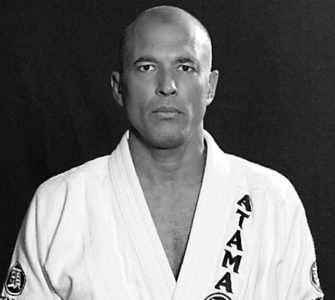Guard passing is one of the most difficult tasks we face when we’re training or competing in BJJ. The legs and hips of a knowledgeable opponent can offer countless roadblocks to the advancement of our game plan forward towards a dominant position like side control or mount. Of all the guard styles like closed guard, half guard, and such, the one on the top of the list as most frustrating guards to pass would be the inverted guard.
Inverted guard players are frustrating for a variety of reasons. First, there flexibility becomes an extremely powerful weapon. By nature, inversion puts their legs and hips in places that we’re not used to have to address them. In many cases, the inverted guard players are outnumbered by the students who don’t play inverted guard, so you may not face this type of guard often enough to become proficient at dealing with it.
Another frustrating aspect of the inverted guard player’s game is that mentally, we feel as if we are past the legs and there they pop up in our face threatening a variety of submissions. If you’re not careful, you can be caught in any number of arm bar or triangle variations and more.
In his High Efficiency No Gi Jiu Jitsu: Top Game BJJ instructional from BJJ Fanatics, Yuri Simoes proposes an easy solution to dealing with the inverted guard players at your academy or on the competition mats. This is straight from his instructional, so when you want more just click the easy to follow button and get yourself a copy.

The Pass
Yuri sets up a fairly standard No Gi pass where he looks to control the opponents hip and bottom thigh to keep them immobile as he walks around to make the pass. In this case, the opponent responds by inverting onto his neck and shoulders keeping his legs, thighs and hips in front of Yuri.
In many cases, this simple, yet effective pass will work to progress one’s game, but in this case, the bottom player is one of those frustrating inverted guard players.

Facing the Inversion
The inverted guard player keeps their legs in front of their opponents and look to trap limbs in a potential web of submissions, such as armbars and triangles just to name a few. The first step is to ensure that your limbs are not susceptible to being snatched and that your posture keeps your neck safe from triangles.

Controlling the Inversion
Yuri recommends cupping the outside of the thighs to both put the breaks on the inverted guard and also keeps his arms safe from submission attempts. After he cups the thighs, he also pushes his elbows outward to keep tension on the opponent’s legs to further prevent their ability to adjust position or attack. This grip keeps the legs of the opponent controlled, while also safely keeping your arms safe from possible arm attacks.

Closing the Distance
Once the grips are secured, Yuri will close the distance and bring the opponent’s hips close to his body to stay connected and help control them further. This allows one to begin making the pass safely without being in the attack range of the legs. If the distance is not closed, the opponent will have the necessary space available to them to stay inverted and on the attack.

Lace the thighs
After closing the distance, Yuri will pick and side and lace his arm completely through to the far side thigh, essentially smashing the legs together despite them being upright and in the air. This further controls the hips and thighs and begins to set up the pass. This works similarly to a leg weave pass in classic half guard. By connecting the legs together and controlling them, they will be less likely to make the necessary adjustments to recover their guard.

Keep the head tight
It’s crucial to keep the head tight to the hips and body of the opponent to ensure that they cannot frame on your head, creating distance and allowing them to escape one of their legs from your lace. The tighter the head can be kept the more pressure that the opponent will feel on their hips as you drag them and walk around to side control.

Making the pass
Once the hips are tied up and your head is kept tight, it is time to begin the pass. By dragging the hips down and walking around their hips, the arm control will keep them from freeing their hips and recovering their guard. The steady strong pressure of Yuri’s shoulders coupled with the controlling arm woven between across their hips, there is nothing they can do but sit back and watch the pass happen.

Side Control
After passing the legs, the hard work is over and now it’s time to secure side control or continue to mount or some other dominant position. By protecting one’s limbs and controlling the inverted hips, closing the distance and staying tight to their hips, the pass can be completed. This is another clear case of staying tight and connecting making a technique successful, instead of backing away and staying in the danger zone.

Now that you’re armed with this simple, easy way to pass the ever-frustrating inverted guard players, you will want to head over to BJJ Fanatics and check out the full course from Yuri Simoes in his High Efficiency No Gi Jiu JItsu: Top Game.



















